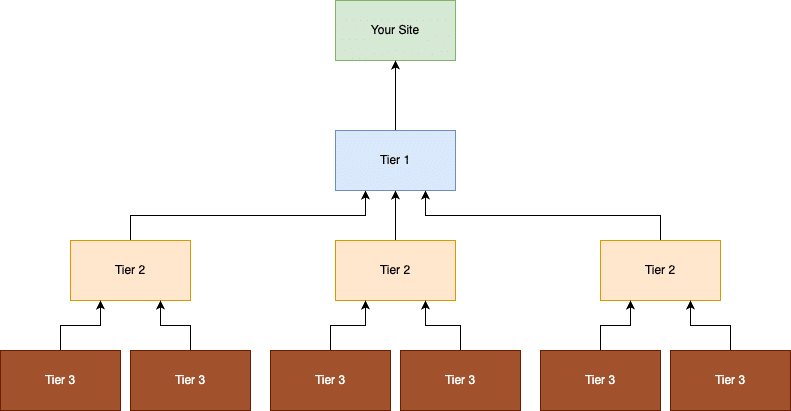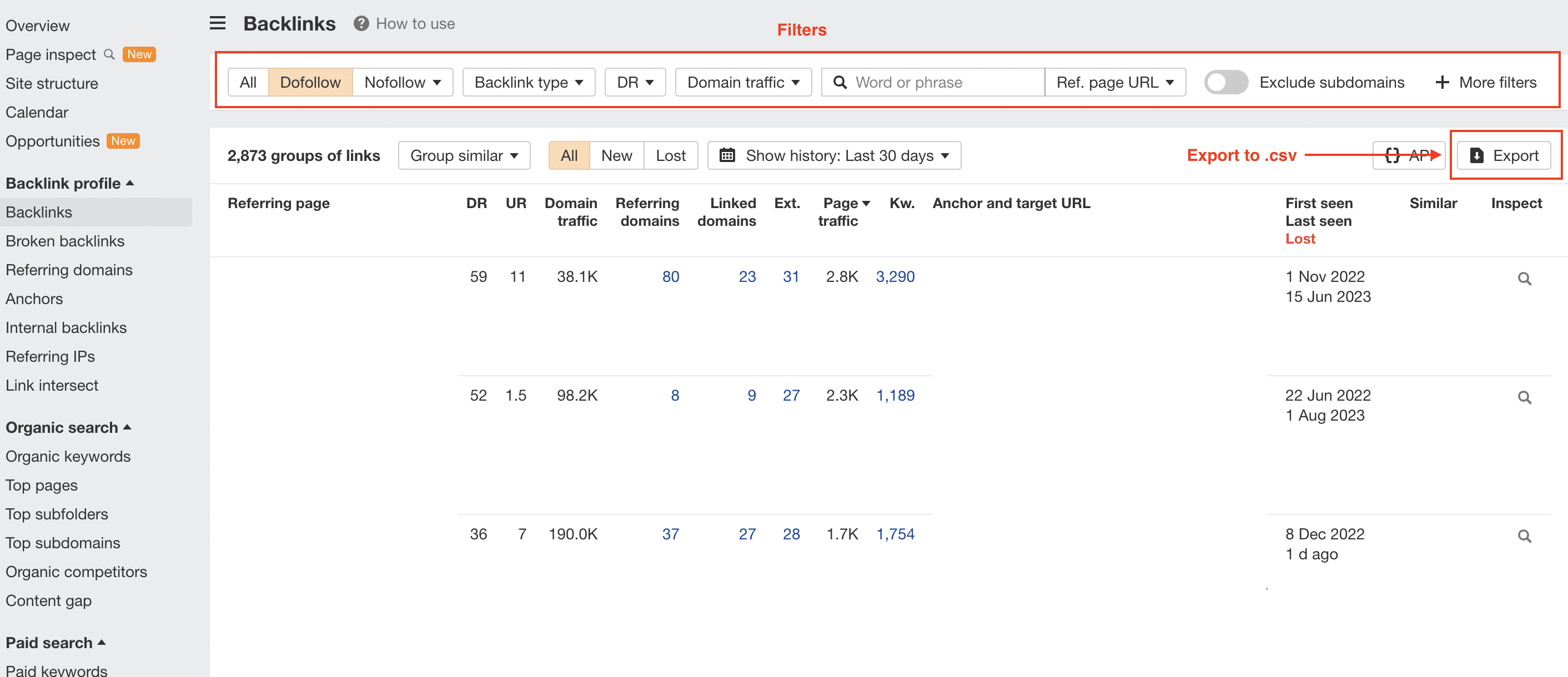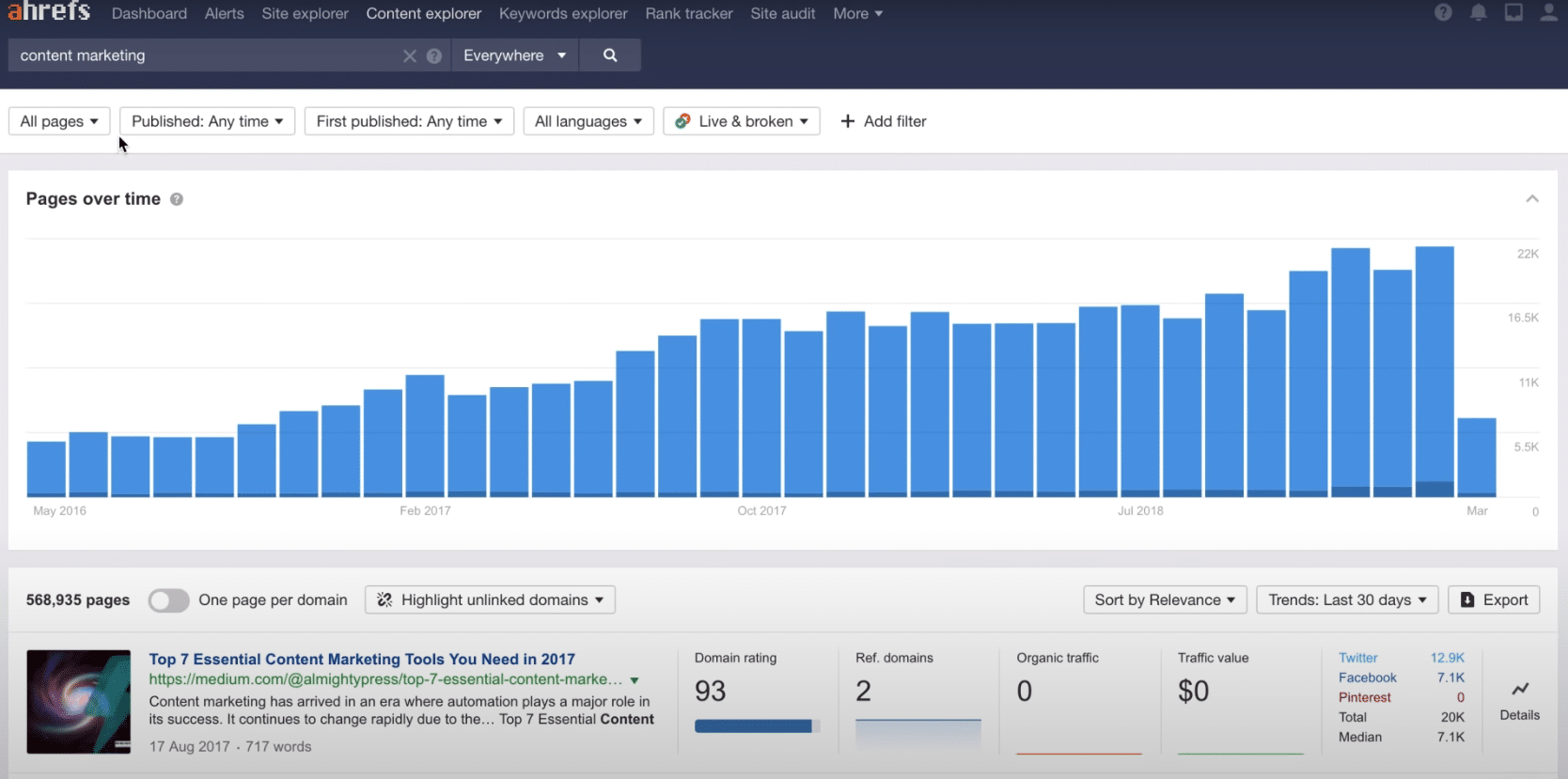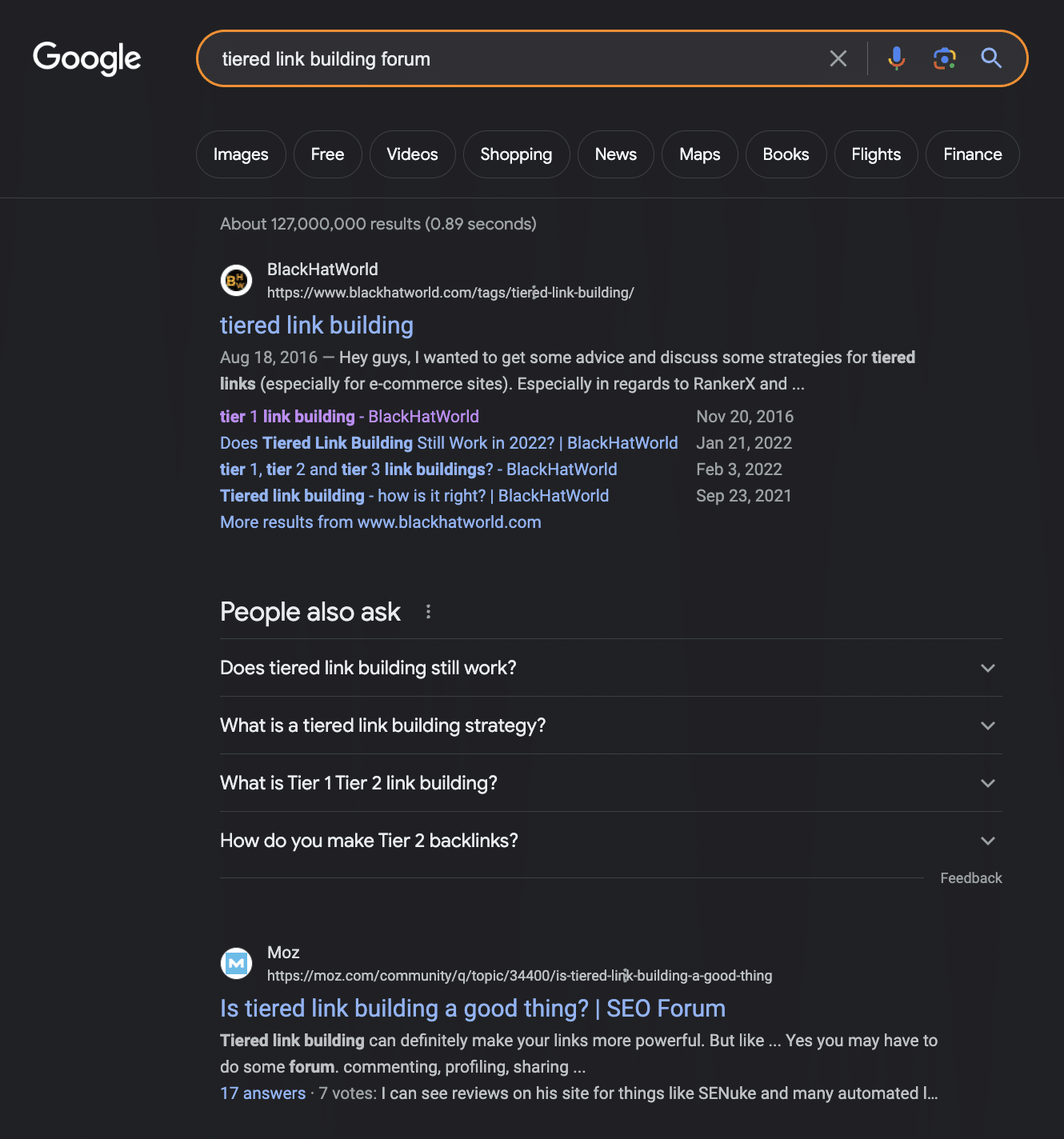One of the most effective link building strategies is tiered link building. Tiered link building is a technique that involves creating multiple layers or tiers of backlinks that point to each other and ultimately to your site. By doing this, you can increase the authority and relevance of your backlinks, boost your organic traffic and rankings, diversify your link profile, and avoid algorithm updates and penalties.
In this guide, we will cover everything you need to know about tiered link building in 2023. We will explain what tiered link building is, how it works, why it is important for SEO, and how to do it effectively using Ahrefs tools. We will also share some tips and best practices for tiered link building in 2023.
What Is Tiered Link Building and How Does It Work?
Tiered link building is a link building technique that involves creating multiple layers or tiers of backlinks that point to each other and ultimately to your site. The idea behind tiered link building is to pass more link juice or authority from one tier to another, and eventually to your site.
Link juice is a term that refers to the amount of authority and value that a backlink passes from one site to another. The more link juice a backlink has, the more it can improve the ranking and visibility of the site that receives it.
The concept of tiered link building can be illustrated with a simple diagram:

As you can see from the diagram, there are three tiers of backlinks in this example:
- Tier 1: These are the backlinks that point directly to your site. These are the most important and valuable backlinks for your SEO, as they have the most direct impact on your ranking and traffic. Therefore, these backlinks should be high-quality and relevant to your site’s niche and topic. They should also come from authoritative and trustworthy sites that have high domain rating (DR) and organic traffic.
- Tier 2: These are the backlinks that point to your tier 1 backlinks. These are the second most important and valuable backlinks for your SEO, as they can increase the authority and relevance of your tier 1 backlinks. Therefore, these backlinks should be medium-quality and diverse in terms of sources and types. They should also come from relevant and popular sites that have moderate DR and organic traffic.
- Tier 3: These are the backlinks that point to your tier 2 backlinks. These are the least important and valuable backlinks for your SEO, as they have the least direct impact on your ranking and traffic. However, these backlinks can still boost the authority and diversity of your lower tiers of backlinks. Therefore, these backlinks can be low-quality and high-volume in terms of sources and types. They can also come from low-authority and spammy sites that have low DR and organic traffic.
By creating a tiered link structure like this, you can achieve several benefits for your SEO:
- You can increase the authority and relevance of your tier 1 backlinks by passing more link juice from lower tiers.
- You can boost your organic traffic and rankings by improving the visibility and trustworthiness of your site.
- You can diversify your link profile by using a variety of link sources and types for lower tiers.
- You can avoid algorithm updates and penalties by creating a natural and logical link pattern.
Tiered link building is different from other link building strategies in several ways:
- Focus on creating multiple layers of backlinks that point to each other, rather than just one layer of backlinks that point to your site.
- Requires more time and resources than other link building strategies, as you need to create more content and links for each tier.
- Involves more risk management than other link building strategies, as you need to balance the quality and quantity of links for each tier.
Why Should You Use Tiered Link Building for Your SEO Strategy?
Tiered link building is one of the most effective link building strategies for SEO, as it can help you achieve several benefits for your site. Here are some of the main benefits of tiered link building:
- Maximizing the value and impact of your backlinks: By creating multiple tiers of backlinks that point to each other, you can pass more link juice and authority from one tier to another, and ultimately to your site. This way, you can maximize the value and impact of your backlinks, and improve your site’s ranking and visibility on Google.
- Improving your site’s authority, trustworthiness, and relevance: By creating high-quality and relevant backlinks for your tier 1, you can improve your site’s authority, trustworthiness, and relevance in your niche and topic. This way, you can increase your site’s credibility and reputation among your audience and Google.
- Driving more organic traffic and conversions to your site: By boosting your site’s authority, trustworthiness, and relevance, you can drive more organic traffic and conversions to your site. This way, you can grow your online business and achieve your goals.
- Diversifying your link profile: By creating medium-quality and diverse backlinks for your tier 2, and low-quality and high-volume backlinks for your tier 3, you can diversify your link profile and avoid over-optimizing or under-optimizing your links. This way, you can create a natural and balanced link pattern that Google likes.
- Avoiding algorithm updates and penalties: By diversifying your link profile and creating a natural and balanced link pattern, you can avoid algorithm updates and penalties that Google may impose on sites that have unnatural or spammy link profiles. This way, you can protect your site from losing ranking and traffic.
How to Do Tiered Link Building Effectively in 2023?
Ahrefs is one of the best tools for tiered link building, as it can help you with every step of the process. It is a powerful SEO tool that allows you to analyze your site’s backlinks, find new link opportunities, build and optimize your links, monitor and measure your link building results, and more.
Here are the steps to do tiered link building effectively in 2023 using Ahrefs and other tools:
Step 1: Identify and audit your existing backlinks using Ahrefs Site Explorer
The first step to do tiered link building is to identify and audit your existing backlinks using Ahrefs Site Explorer and Backlink Checker. These tools allow you to see all the backlinks that point to your site or any URL on the web. You can also see various metrics for each backlink, such as DR, organic traffic, anchor text, referring domains, etc.
To identify and audit your existing backlinks using Ahrefs Site Explorer, follow these steps:
- Enter your site’s domain or URL in the search bar of Ahrefs Site Explorer.
- Go to the Backlinks report on the left sidebar.
- You will see a list of all the backlinks that point to your site or URL. You can use the filters on the top to narrow down the results by various criteria, such as DR, organic traffic, anchor text, referring domains, etc.
- You can also export the list of backlinks to a CSV file for further analysis.

By identifying and auditing your existing backlinks using Ahrefs Site Explorer you can:
- Find out which backlinks are already pointing to your site or URL
- Evaluate the quality and relevance of each backlink
- Identify which backlinks are suitable for tier 1
- Identify which backlinks need improvement or removal
Step 2: Build high-quality and relevant backlinks for your tier 1
The second step to do tiered link building is to build high-quality and relevant backlinks for your tier 1 using methods like guest posting, resource pages, HARO, or Ahrefs Content Explorer. These methods allow you to create valuable content that attracts backlinks from authoritative and trustworthy sites in your niche and topic.
To build high-quality and relevant backlinks for your tier 1 using methods like guest posting, resource pages, HARO, or Ahrefs Content Explorer, follow these steps:
Guest posting
This is a method where you write and publish an article on another site that accepts guest posts. You can include a link to your site or URL in the article or in the author bio. To find guest posting opportunities using Ahrefs, follow these steps:
- Enter your niche or topic keyword in the search bar of Ahrefs Content Explorer.
- Go to the Referring domains report on the left sidebar.
- You will see a list of sites that have linked to at least one article on your niche or topic. You can use the filters on the top to narrow down the results by various criteria, such as DR, organic traffic, language, etc.
- You can also export the list of sites to a CSV file for further analysis.
- For each site, check if they accept guest posts by looking at their guidelines, previous guest posts, or contact page. You can also use Google search operators like “site:domain.com” + “write for us” or “guest post” or “guest post by” to find their guest posting guidelines.
- Once you find a suitable site, pitch them your article idea and follow their guidelines. Make sure to write a high-quality and relevant article that provides value to their audience and includes a link to your site or URL.

Resource pages
These are pages that list and link to useful resources on a specific niche or topic. You can get a link from these pages by suggesting your site or URL as a resource. To find resource pages using Ahrefs, follow these steps:
- Enter your niche or topic keyword in the search bar of Ahrefs Keywords Explorer.
- Go to the Matching terms report on the left sidebar.
- You will see a list of keyword ideas related to your niche or topic. You can use the filters on the top to narrow down the results by various criteria, such as keyword difficulty, search volume, etc.
- Look for keywords that indicate resource pages, such as “resources”, “links”, “tips”, “guide”, etc. For example, if your niche or topic is “tiered link building”, you can look for keywords like “tiered link building resources”, “tiered link building links”, “tiered link building tips”, etc.
- For each keyword, check the SERP overview on the right side to see the top 10 ranking pages for that keyword. You can also click on the SERP button to see the full SERP analysis for that keyword.
- For each page, check if they are a resource page that lists and links to useful resources on your niche or topic. You can also use Ahrefs SEO Toolbar to see the DR and organic traffic of each page.
- Once you find a suitable resource page, contact them and suggest your site or URL as a resource. Make sure to explain why your site or URL is relevant and valuable for their audience and include a link to it.

You can also use link building tactics such as link exchanges or link insertions – which we have covered in their respective guides.
By building high-quality and relevant backlinks for your tier 1 using methods like guest posting, resource pages, link insertions, or link exchanges, you can:
- Improve your site’s authority, trustworthiness, and relevance in your niche and topic
- Drive more organic traffic and conversions to your site
- Create a strong foundation for your tiered link structure
Step 3: Build medium-quality and diverse backlinks for your tier 2
The third step to do tiered link building is to build medium-quality and diverse backlinks for your tier 2 using methods like web 2.0s, social media, infographics, or Ahrefs Link Intersect. These methods allow you to create various types of content and links that point to your tier 1 backlinks.
To build medium-quality and diverse backlinks for your tier 2 using methods like web 2.0s, social media, infographics, or Ahrefs Link Intersect, follow these steps:
Web 2.0s

These are sites that allow users to create and publish their own content, such as blogs, wikis, forums, etc. You can create web 2.0s on platforms like WordPress, Blogger, Medium, Tumblr, etc. You can include a link to your tier 1 backlink in your web 2.0 content. To create web 2.0s, follow these steps:
- Choose a platform that suits your niche and topic. For example, if your niche or topic is “link building”, you can choose WordPress as a platform.
- Create an account on the platform and set up your web 2.0 site. You can use a relevant and catchy name for your site, such as “Link Building Tips” or “Link Building Guide”.
- Create and publish high-quality and relevant content on your web 2.0 site that provides value to your audience and includes a link to your tier 1 backlink. You can use Ahrefs Content Explorer to find content ideas and Ahrefs Keywords Explorer to find keywords for your content.
- Promote your web 2.0 site and content on social media and other platforms to get more exposure and traffic.
Social media

These are platforms that allow users to share and interact with various types of content, such as text, images, videos, etc. You can create social media profiles and pages on platforms like Facebook, Twitter, Instagram, LinkedIn, etc. You can include a link to your tier 1 backlink in your social media posts and bio. To create social media profiles and pages, follow these steps:
- Choose a platform that suits your niche and topic. For example, if your niche or topic is “tiered link building”, you can choose LinkedIn as a platform.
- Create an account on the platform and set up your social media profile or page. You can use a relevant and professional name for your profile or page, such as “Link Building Expert” or “Link Building Consultant”.
- Create and share high-quality and relevant content on your social media profile or page that provides value to your audience and includes a link to your tier 1 backlink.
- Engage with your social media followers and other users on the platform to get more exposure and traffic.
Infographics

These are visual representations of data or information that are easy to understand and share. You can create infographics on topics related to your niche or topic using tools like Canva or Piktochart. You can include a link to your tier 1 backlink in your infographic or in the source section. To create infographics, follow these steps:
- Choose a topic that is relevant and interesting for your niche or topic. For example, if your niche or topic is “tiered link building”, you can choose a topic like “The Benefits of Tiered Link Building” or “How Tiered Link Building Works”.
- Find data or information for your topic using Ahrefs Content Explorer or Ahrefs Keywords Explorer. You can use the filters and metrics to find the most relevant and popular data or information for your topic.
- Create an infographic using a tool like Canva or Piktochart. You can use templates, icons, charts, colors, fonts, etc. to make your infographic attractive and informative. You can include a link to your tier 1 backlink in your infographic or in the source section.
- Promote your infographic on social media and other platforms to get more exposure and traffic. You can also reach out to other sites that have shared similar infographics and ask them to share yours.
Ahrefs Link Intersect
This is a tool that allows you to find sites that link to your competitors but not to you. You can get a link from these sites by reaching out to them and offering them your site or URL as a resource. To find sites using Ahrefs Link Intersect, follow these steps:
- Enter your site’s domain or URL in the search bar of Ahrefs Site Explorer.
- Go to the Link Intersect report on the left sidebar.
- You will see a table where you can enter up to 10 competitors’ domains or URLs in the top row, and your site’s domain or URL in the bottom row. You can also use the filters on the top to narrow down the results by various criteria, such as DR, organic traffic, link type, etc.
- You will see a list of sites that link to your competitors but not to you. You can use the metrics on the right to evaluate the quality and relevance of each site.
- For each site, check if they are relevant and interested in your niche or topic. You can also use Ahrefs SEO Toolbar to see the DR and organic traffic of each site.
- Once you find a suitable site, contact them and offer them your site or URL as a resource. Make sure to explain why your site or URL is relevant and valuable for their audience and include a link to it.
By building medium-quality and diverse backlinks for your tier 2 using methods like web 2.0s, social media, infographics, or Ahrefs Link Intersect, you can:
- Increase the authority and relevance of your tier 1 backlinks by passing more link juice from lower tiers
- Diversify your link profile by using a variety of link sources and types for lower tiers
- Create a natural and logical link structure that Google likes
Step 4: Build low-quality and high-volume backlinks for your tier 3
The fourth step to do tiered link building is to build low-quality and high-volume backlinks for your tier 3 using methods like blog comments, forum posts, or directories. These methods allow you to create large amounts of backlinks that point to your tier 2 backlinks.
To build low-quality and high-volume backlinks for your tier 3 using methods like blog comments and forum posts, follow these steps:
Blog comments

These are comments that you leave on other blogs that are related to your niche or topic. You can include a link to your tier 2 backlink in your comment. To find blog comment opportunities, follow these steps:
- Enter your niche or topic keyword in the search bar of Ahrefs Content Explorer.
- Go to the Comments report on the left sidebar.
- You will see a list of content pieces that have comments on them. You can use the filters on the top to narrow down the results by various criteria, such as DR, organic traffic, language, etc.
- For each content piece, check if it is relevant and interesting for you and if it allows comments with links. You can also use Ahrefs SEO Toolbar to see the DR and organic traffic of each content piece’s site.
- Once you find a suitable content piece, leave a comment that provides value to the author and the audience and includes a link to your tier 2 backlink.
Forum posts
These are posts that you make on online forums that are related to your niche or topic. You can include a link to your tier 2 backlink in your post or in your signature. To find forum post opportunities, follow these steps:
- Enter your niche or topic keyword in the search bar of Ahrefs Keywords Explorer.
- Go to the SERP overview report on the left sidebar.
- You will see a list of keywords related to your niche or topic. You can use the filters on the top to narrow down the results by various criteria, such as keyword difficulty, search volume, etc.
- Look for keywords that indicate forum posts, such as “forum”, “discussion”, “community”, etc. For example, if your niche or topic is “tiered link building”, you can look for keywords like “tiered link building forum”, “tiered link building discussion”, “tiered link building community”, etc.
- For each keyword, check the SERP overview on the right side to see the top 10 ranking pages for that keyword. You can also click on the SERP button to see the full SERP analysis for that keyword.
- For each page, check if it is a forum post that is relevant and interesting for you and if it allows posts with links. You can also use Ahrefs SEO Toolbar to see the DR and organic traffic of each page’s site.
- Once you find a suitable forum post, make a post that provides value to the forum members and includes a link to your tier 2 backlink.

If Ahrefs doesn’t work, you can simply Google the desired keyword and then use extensions to find out the desired metrics of a forum.
By building low-quality and high-volume backlinks for your tier 3 using methods like blog comments and forum posts, you can:
- Boost the authority and diversity of your lower tiers of backlinks by passing more link juice from lower tiers
- Avoid algorithm updates and penalties by creating a natural and balanced link pattern
- Create a large amount of backlinks that point to your tier 2 backlinks
Tips and Best Practices for Tiered Link Building in 2023
Tiered link building is a powerful link building strategy that can help you rank higher on Google and grow your online business. However, it is also a complex and risky strategy that requires careful planning and execution. Here are some tips and best practices for tiered link building in 2023:
Focus on quality over quantity for your tier 1 backlinks
Your tier 1 backlinks are the most important and valuable backlinks for your SEO, as they have the most direct impact on your ranking and traffic. Therefore, you should focus on creating high-quality and relevant backlinks that come from authoritative and trustworthy sites in your niche and topic.
You should also use relevant and natural anchor texts and keywords for your tier 1 backlinks, as they signal the context and relevance of your site or URL to Google. You should avoid using exact match or over-optimized anchor texts and keywords, as they may trigger red flags and penalties from Google.
Use a variety of link sources and types for your lower tiers
Your lower tiers of backlinks are the second most important and valuable backlinks for your SEO, as they can increase the authority and relevance of your tier 1 backlinks. Therefore, you should use a variety of link sources and types for your lower tiers, such as web 2.0s, social media, infographics, etc.
You should also keep your tiered link structure natural and logical, as it reflects the natural flow of information and value on the web. You should avoid using too many or too few links for each tier, or creating unnatural or spammy link patterns, as they may trigger red flags and penalties from Google.
Avoid over-optimizing or under-optimizing your links, and balance your dofollow and nofollow links
Your links are the main elements of your tiered link building strategy, as they pass link juice and authority from one tier to another, and ultimately to your site. Therefore, you should avoid over-optimizing or under-optimizing your links, as they may affect the performance and SEO of your site.
You should also balance your dofollow and nofollow links, as they signal the trustworthiness and diversity of your site to Google. Dofollow links are links that pass link juice and authority to the site that receives them, while nofollow links are links that do not pass link juice and authority to the site that receives them.
You should aim for a natural ratio of dofollow and nofollow links for each tier, such as 70% dofollow and 30% nofollow for tier 1, 50% dofollow and 50% nofollow for tier 2.
Avoid creating unnatural or spammy link patterns
Your link patterns are the way you distribute your links across different tiers, sources, types, etc. They reflect the strategy and logic behind your tiered link building efforts. Therefore, you should avoid creating unnatural or spammy link patterns, such as linking to the same site or URL multiple times from different tiers, linking to unrelated or low-quality sites or URLs from any tier, linking to sites or URLs that have been penalized by Google from any tier, etc.
You should also check your competitors’ link profiles for inspiration, as they can give you an idea of what works well in your niche or topic. You can use Ahrefs Site Explorer or Ahrefs Link Intersect to see how your competitors build their links.
Wrapping Up
Tiered link building is a link building technique that involves creating multiple layers or tiers of backlinks that point to each other and ultimately to your site. By doing this, you can increase the authority and ultimately to your site. By doing this, you can increase the authority and relevance of your backlinks, boost your organic traffic and rankings, diversify your link profile, and avoid algorithm updates and penalties.

